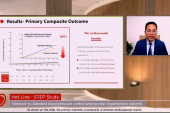Higher Dose vs Added Antihypertensive? Older Patients Face Trade-offs
The study of veterans, however, showed that the simpler regimen of maxing out the original drug’s dose is more sustainable.

Maximizing the dose of an antihypertensive medication might be a simpler and more manageable strategy than adding a new drug in older patients with hypertension, but it’s less effective at lowering blood pressure, according to new observational data.
The SPRINT trial and others have endorsed the intensification of medications in hypertensive adults. However, guidelines differ on preferred approaches—the latest European advice supports two or more medications working in combination, while US documents do not promote a specific tactic except for patients deemed high risk.
“It's good news on both fronts,” senior author Lillian Min, MD (University of Michigan, Ann Arbor), told TCTMD. “We have lots of tools and lots of different medicines to be able to use for controlling blood pressure, and we're understanding more and more as research is being conducted on the benefits of blood pressure management in older patients. This is just another small tool in the armamentarium: you've got benefits whichever strategy you choose, and that way you can tailor your recommendations to your patients in the course of caring for their hypertension over time.”
Commenting on the study for TCTMD, James Sheppard, PhD (University of Oxford, England), observed that the options aren’t equivalent, though. “There's a trade-off depending on the extent of blood pressure-lowering effect you want and the persistence of treatment.” He added that he would likely only use the dose-intensification approach if he was concerned about adherence.
Min agreed that, in the “post-SPRINT era,” to maximize blood pressure-lowering she would tend to add a medication before upping the dose of an existing one. “But if the patient has a lot of medications and they're at risk of having side effects, . . . then staying with a lower number of medications and just changing the dose of them is probably the way to go,” she said.
Greater BP Drop With More Pills
In 25.5% of patients, intensification of therapy was achieved by adding a new medication. In the remaining 74.5% of patients, this was done by maximizing the dose without the addition of a new drug.
Over 3 months, patients whose existing dosage was increased were more likely to have maintained or improved upon their overall level of antihypertensive-therapy intensity than those who had a new drug added (65.0% vs 49.8%). This relationship was maintained after adjusting for baseline systolic BP and total number of medications; the difference was sustained at 12 months.
On the other hand, adding a new medication was associated with a greater decrease in systolic blood pressure at 3 months as compared with maximizing the dose (-4.6 vs -3.8 mm Hg). This improvement was still present at 12 months, with a difference of -1.1 mm Hg between the two strategies.
Younger patients and those with higher baseline systolic blood pressure were more likely to have had a new medication added. “We were reassured that the most common approach is to increase a dose of the medication that is already existing and that is a safer approach,” Min said. However, “it's a little bit of a presumption that it was safer.”
Researchers assumed that patients who did not maintain the intensified dose went off of it because “something happened,” Min explained. ”Either they couldn't maintain it because of a side effect [or] they couldn't maintain it because it was too complicated. . . . So it's a little bit of a leap of faith to say that it was safer and less complex to increase the dose.” But the “substantial difference” in how many from each group stayed on the intensified therapy was “the most surprising,” Min added.
The difference in reduction in blood pressure with the addition of a new drug was the “more splashy result,” although the win was only “by a hair’s length,” she said. “So both approaches do lower the blood pressure, but it was just a 1mm Hg difference in a large data set.”
Min also highlighted a secondary finding showing that patients with higher baseline systolic blood pressure saw the greatest reduction by adding a new medication. “So if the patient has a higher blood pressure or if we want to get to the lower blood pressure faster, because they are relatively healthy and they don't have a lot of other medications or other comorbid conditions, then this might be an option that will get them to a lower blood pressure faster or even to meet the new guidelines faster,” she said.
Missing Adverse Events
Sheppard commented that the lack of detailed data looking at adverse events “was a bit of a missed opportunity,” because this is what physicians and patients are most worried about when planning prescriptions. This is important for older patients in whom kidney problems or falls and fractures are a greater concern, he added.
Going forward, Sheppard said he would like to see a randomized trial that, beyond studying just blood pressure changes and treatment sustainability, looks at “the adverse event profile of the two strategies and what the likelihood of suffering side effects would be.”
Min said more work is needed studying how patient preference and communication comes into play for these decisions, as well as for adherence. “Patients vary greatly in terms of how much they value the simplicity of their drug regimens,” she said. “Some patients find it very burdensome. And so I think that finding better ways to approach how to tailor our recommendations to our patient preferences and what will be the most successful is the next area of research.”
In an accompanying editorial, Olivier Steichen, MD, PhD (Assistance Publique-Hôpitaux de Paris and Sorbonne Université, Paris, France), writes that “the main shortcoming of the study lies in the broad spectrum of baseline situations.” The heterogeneous case mix included here doesn’t allow for “definitive conclusions on how best to intensify treatment in patients with uncontrolled hypertension, in general or in any given situation,” he adds.
However, the findings lend some clinical support to physicians prescribing antihypertensives and encourage them to keep things simple, Steichen says. “When intensification is indicated, we should not waste time with elaborate reasoning: Either add a drug or maximize the dose of existing drugs, whichever seems to fit best with the patient's current treatment, clinical state, and preferences.”
He also advises a follow-up visit 1 month after the initial prescription to “assess adherence, tolerance, and effectiveness and to perform further adjustments if needed.”
Yael L. Maxwell is Senior Medical Journalist for TCTMD and Section Editor of TCTMD's Fellows Forum. She served as the inaugural…
Read Full BioSources
Aubert C, Sussman JB, Hofer TP, et al. Adding a new medication versus maximizing dose to intensify hypertension treatment in older adults: a prospective observational study. Ann Intern Med. 2021;Epub ahead of print.
Steichen O. How to intensify treatment in older patients with hypertension: Is there a single answer? Ann Intern Med. 2021;Epub ahead of print.
Disclosures
- Aubert, Min, Steichen, and Sheppard report no relevant conflicts of interest.





Comments